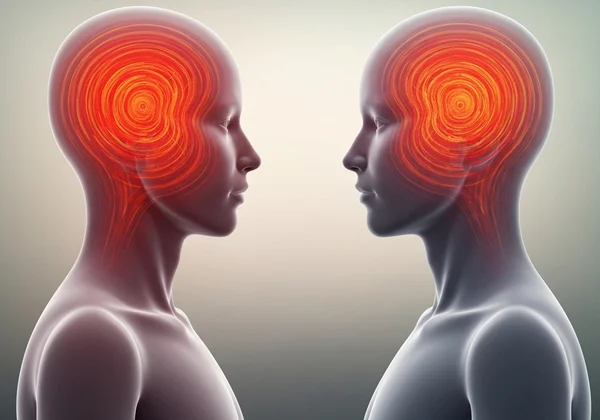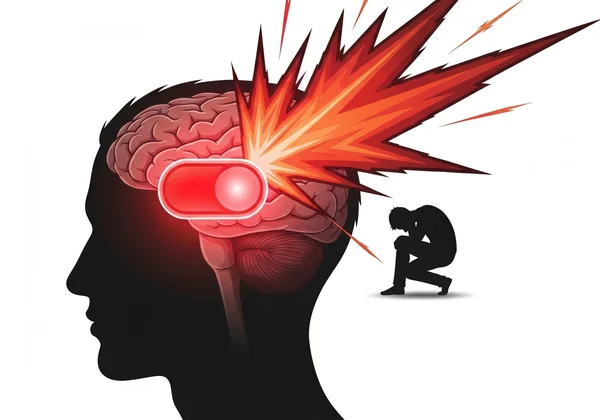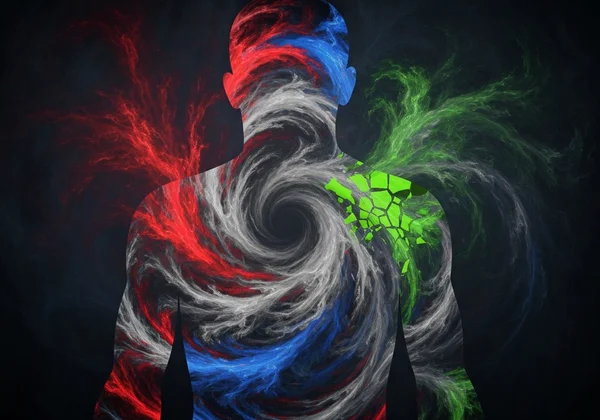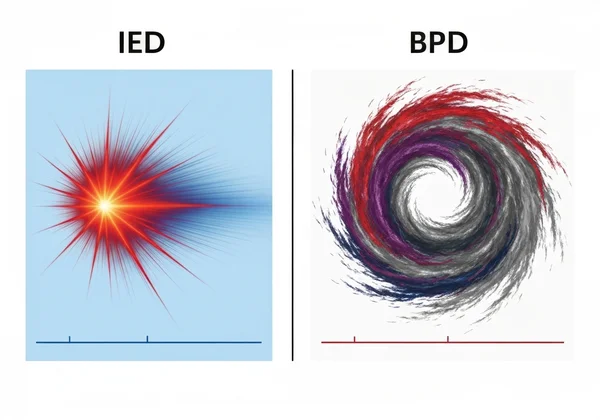间歇性爆发性障碍 (IED) 与边缘性人格障碍 (BPD):理解爆发性情绪失控
面对情绪爆发的复杂世界可能会令人困惑,尤其是当间歇性爆发性障碍 (IED) 和边缘性人格障碍 (BPD) 等疾病共享愤怒和冲动等重叠症状时。许多人想知道,我如何判断我的愤怒属于 IED 还是其他原因? 本指南将提供清晰的比较分析,帮助您了解每种疾病中爆发性愤怒的独特之处。掌握这些区别对于理解至关重要。请记住,此信息仅用于教育目的,不能替代专业的医疗诊断。要初步了解您自己的模式,您可以随时使用我们的在线工具进行 免费的 IED 评估。

间歇性爆发性障碍:它是什么?
间歇性爆发性障碍 (IED) 是一种冲动控制障碍,其特征是反复出现行为爆发,表现为无法控制攻击性冲动。这些发作可能导致言语攻击(发脾气、谩骂、口头争吵)或对财产、动物或其他人的身体攻击。其关键特征是,反复发作期间表现出的攻击性程度与挑衅或任何促发性社会心理压力源严重不成比例。
定义 IED:不仅仅是脾气暴躁
很容易将反复出现的愤怒爆发简单地归结为仅仅是 脾气不好,但这种情况是独特的且可诊断的。根据 DSM-5 标准,这些爆发性发作并非预谋;它们是冲动性的和/或基于愤怒的。它们不是为了实现金钱或权力等任何实际目标而进行的。这些爆发会导致个体明显的痛苦、职业或人际关系功能受损,或造成经济或法律后果。为了更好地了解您的经历是否符合这些模式,一份保密的 愤怒自我评估 可以是一个有益的起点。
常见诱因与 IED 的感受
对于患有这种疾病的人来说,这种经历常常感觉像是情绪瞬间失控了。这些爆发的诱因通常是轻微的挑衅或挫折,而这些在大多数人身上不会引起如此极端的反应——例如交通堵塞、电脑运行缓慢或一次随意的争执。在爆发之前,一个人可能会感到紧张、烦躁或愤怒的积聚。爆发本身是短暂的,通常持续不到 30 分钟。爆发后最明显的感受往往是深深的解脱感,随后迅速被对自身行为的强烈后悔、懊悔、羞耻或尴尬所取代。

边缘性人格障碍:愤怒与失调
边缘性人格障碍 (BPD) 是一种广泛的精神健康障碍,它影响您对自身和他人的思考和感受方式,导致日常生活功能出现问题。它包括不稳定的人际关系、扭曲的自我形象、极端情绪和冲动性。虽然强烈愤怒是一个标志性症状,但它只是 情绪失调 这一更广泛模式中的一部分。
BPD 的核心症状:愤怒的作用
BPD 中的愤怒并非孤立存在。它与其他 BPD 症状 紧密交织。这些症状包括对遗弃(真实或想象的)的疯狂恐惧、不稳定和强烈的人际关系模式、身份障碍以及慢性空虚感。BPD 中的愤怒通常被描述为强烈、不恰当且难以控制。它可能表现为频繁发脾气、持续愤怒或反复的肢体冲突。
BPD 中的冲动性攻击:更深层的原因
与另一种疾病中突然的、反应性的爆发不同, BPD 中的冲动性攻击 往往根植于更深层的情感脆弱性。这种愤怒常常由感知到的人际轻视、批评或对被所爱之人遗弃的恐惧所触发。这种愤怒可能以爆发性的形式向外发泄,但也可能向内发泄,导致自伤行为或自杀念头。情绪动荡在爆发后不会迅速平息,反而常常会加剧该疾病的持续不稳定状态。

IED 与 BPD:爆发的关键区别
虽然这两种情况都涉及爆发性愤怒,但其“原因”、“方式”及“后续发展”有着根本性的不同。区分它们至关重要,因为它决定了最有效的治疗和管理途径。了解您的独特经历是第一步,而 免费的 IED 测试 可以提供宝贵的个人见解。
愤怒的性质:动机与持续时间
最明显的区别之一在于 愤怒模式。
- 对于这种冲动控制障碍: 愤怒几乎纯粹是反应性和冲动性的。它是一种“突如其来”的爆发,与更广泛的情绪状态无关。爆发是短暂的,一旦结束,个体通常会恢复正常情绪状态(事后会感到内疚除外)。这被认为是“自我失调的”,意味着这种行为与个体的自我概念不一致;他们不想这样。
- BPD: 愤怒是慢性且普遍的情绪不稳定模式的一部分。它通常由对遗弃的强烈恐惧或对其自我感的感知威胁所驱动。情绪风暴可以持续数小时甚至数天,并且与焦虑、抑郁和空虚等其他感受交织在一起。
| 特征 | 间歇性爆发性障碍 | 边缘性人格障碍 (BPD) |
|---|---|---|
| 主要性质 | 一种冲动控制障碍 | 一种人格障碍 |
| 愤怒焦点 | 爆发是核心问题 | 愤怒是众多症状之一 |
| 诱因 | 轻微的外部挫折 | 人际冲突,对遗弃的恐惧 |
| 发作持续时间 | 短暂,通常少于 30 分钟 | 可能延长,持续数小时或数天 |
| 发作间歇期 | 情绪通常稳定 | 慢性情绪失调,空虚感 |
| 后果 | 懊悔、内疚、尴尬 | 持续的情绪动荡、自伤 |

诱因、后果与更广泛的背景
爆发周围的背景提供了更多线索。如前所述,这些爆发性发作的诱因往往出人意料地轻微。爆发后,个体通常会感到真诚的懊悔。相比之下,BPD 的诱因是深刻的个人和关系层面的。后果可能包括持续的冲突、自毁行为和更深的绝望。BPD 中的愤怒是个人与自身身份和人际关系斗争的一部分,而对于这种冲动控制障碍,愤怒 就是 这种斗争。
鉴别诊断:为何准确性至关重要
获得 鉴别诊断 不仅仅是一项学术练习;它对康复至关重要。这种疾病的治疗通常侧重于冲动控制、愤怒管理技巧和认知行为疗法 (CBT),以识别诱因并管理愤怒反应。BPD 的治疗更为全面,通常涉及辩证行为疗法 (DBT),它在更广泛的背景下处理情绪调节、痛苦耐受力和人际效能。采用错误的方法可能无效且令人沮丧。
寻求清晰:何时寻求专业帮助
如果本文中描述的模式与您或您关心的人产生共鸣,那么迈出下一步是力量的象征。自我教育是强大的,但它不能取代训练有素的精神卫生专业人员的指导,他们可以提供准确的诊断和量身定制的治疗计划。
专业评估包括什么
针对愤怒问题的专业评估 是一次全面的对话,而不是一次可怕的审讯。临床医生(如心理学家或精神科医生)将进行详细的临床访谈,询问您的症状、其频率和严重程度以及它们如何影响您的生活。他们将审查您的个人和家族史,并努力排除可能导致症状的其他情况。这一严谨的过程确保您获得正确的诊断和最有效的帮助。
您的第一步:在线 IED 评估
对自己的经历感到不确定是完全正常的。在安排专业预约之前,进行一次免费、保密的 在线 IED 评估 可以是一个有力的第一步。该工具旨在帮助您在私密、非评判性的空间中反思您与愤怒和冲动相关的经历。它为您提供个性化见解,可以作为与医疗保健提供者对话的绝佳起点。它有助于整理您的思绪,并帮助您找到描述您经历的语言。

理解你的愤怒:一条通往治愈的道路
区分与冲动控制障碍相关的爆发性愤怒和边缘性人格障碍中情绪高度不稳的愤怒是复杂但至关重要的。虽然一种疾病的定义是孤立的、不成比例的愤怒爆发,但 BPD 的愤怒是情绪不稳定和人际关系困难的更大模式中的一个症状。
识别这些区别是迈向治愈的关键第一步。理解愤怒的根源为获得正确的支持、有效的管理策略和更平静的生活打开了大门。我们鼓励您今天就 开始您的免费 IED 评估,掌控您的情绪健康。咨询合格的精神卫生专业人员始终是获得正式诊断的最佳行动方案。
关于爆发性愤怒的常见问题
间歇性爆发性障碍的常见迹象是什么?
最常见的迹象包括反复出现的攻击性爆发,其程度与诱因严重不成比例,言语攻击如发脾气或争吵,和/或身体攻击。这些发作并非预谋,并导致显著的痛苦或功能障碍。
爆发性发作感觉如何?
许多人描述在发作前会感到紧张、烦躁或愤怒的强烈积聚。爆发本身是这种压力的释放,通常被描述为“眼前发红”或失去控制。之后,解脱感很快被深深的羞耻、后悔和尴尬所取代。
间歇性爆发性障碍可以治愈吗?
虽然可能没有“治愈”的方法,但这种情况有很好的治疗效果。通过认知行为疗法 (CBT) 等疗法,有时也包括药物治疗,个体可以学会识别诱因,管理愤怒反应,并显著减少爆发的频率和强度。
我怎么知道我的愤怒是 IED 还是其他情况?
这是一个复杂的问题,只有专业人士才能明确回答。然而,一个关键的区别在于背景。如果您的爆发性愤怒发生在孤立的发作中,而您在其他时候的情绪通常是稳定的,那么它可能更符合冲动控制障碍。如果它是不稳定的人际关系、自我形象和情绪的更广泛模式的一部分,那么它可能与其他情况有关。进行 免费的愤怒自我评估 可以帮助您收集见解,以便与医生讨论。
间歇性爆发性障碍的真正原因是什么?
确切原因尚不清楚,但据信是多种因素的结合。从基因上看,它在家族中有遗传倾向。从环境上看,在有爆发性行为和言语或身体虐待的家庭中成长是一个重要的风险因素。从生物学上看,大脑结构以及血清素这种脑化学物质的功能可能存在差异。